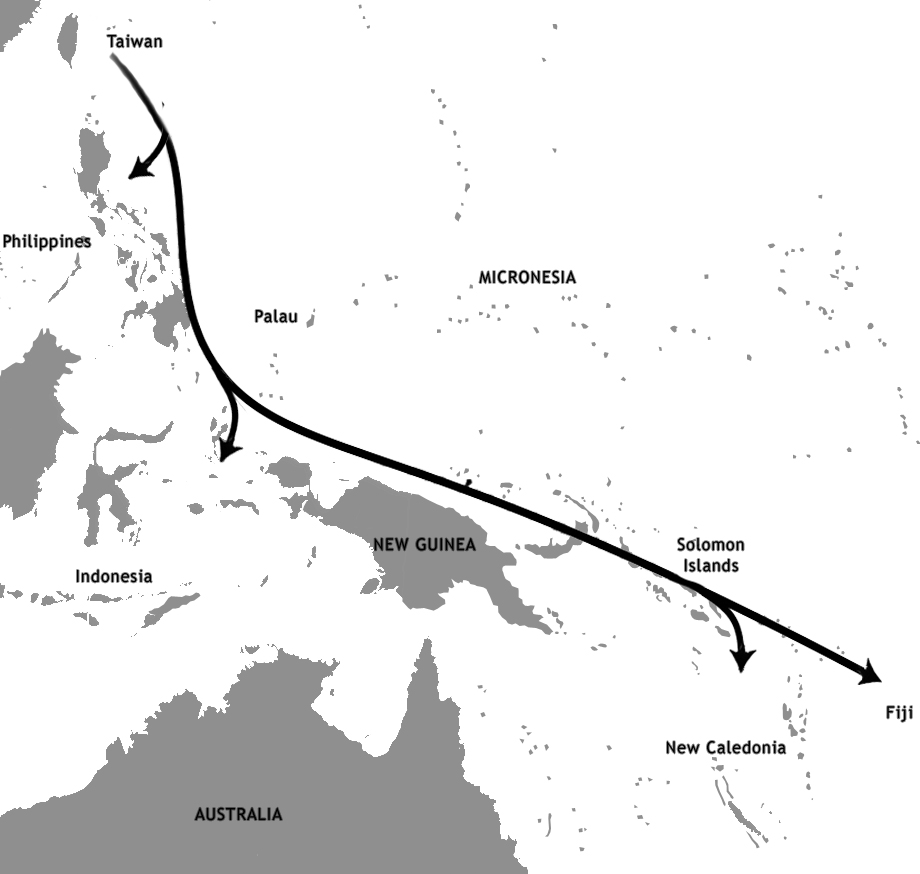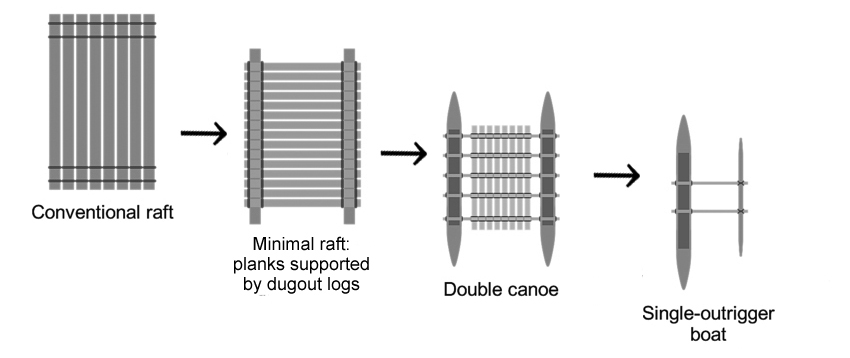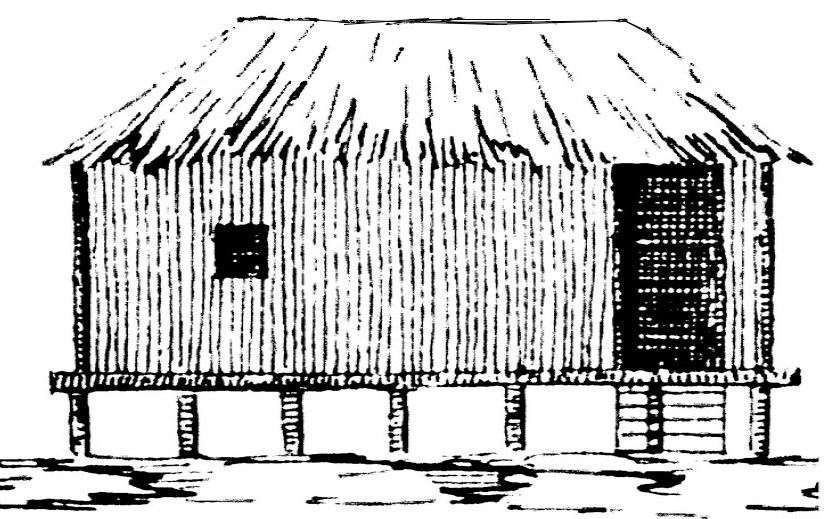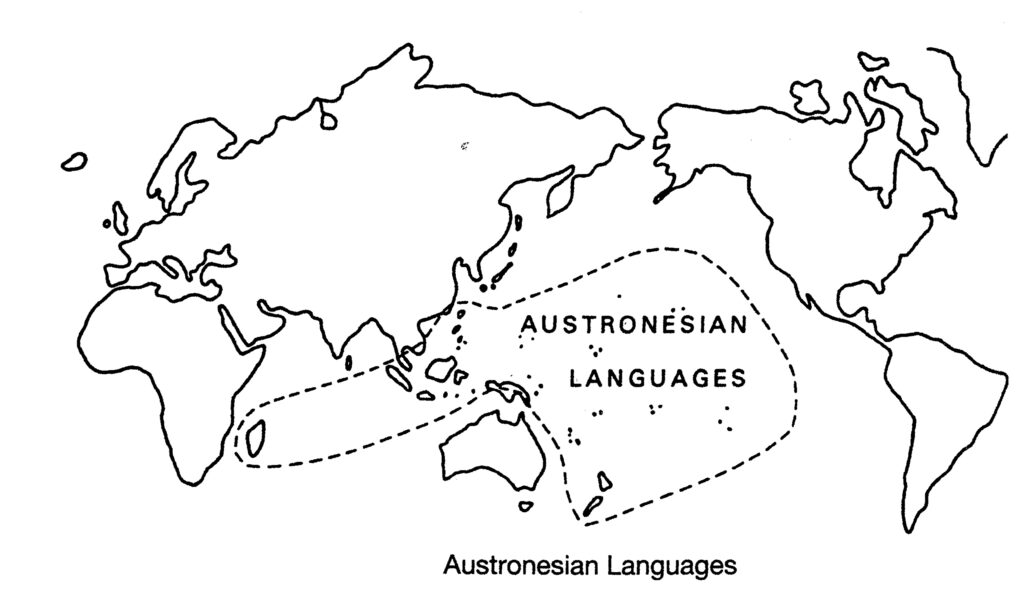3) The Beginning of the Seafarers
(2500 BC-1400 BC)
So where did these restless sea-people, the voyagers who sailed to Melanesia and made their temporary home there, originally come from?
The answer we get from nearly all those who have studied this question is Taiwan, an island just off the coast of China. Taiwan is generally regarded as the starting point: the place in which the Austronesian language family–the broad family that embraces nearly all the major Pacific Island languages–originated. It is also where the seafaring tradition, the navigational skills, and so many of the other cultural traits associated with early island societies were formed.
Taiwan seems to have been the place at which the languages and cultural features of all Micronesians–including Yapese and Palauans–began. The dispersal of this family throughout the region started about 2,500 years before Christ. It was a process that went on for the next 4,000 years as voyagers reached just about every island in the Pacific. Changes occurred along the way, of course. Tools were improved, the canoes were modified, the diet changed according to the environment, and cultural practices were adapted in many ways. Still, the founders of the family can be traced to Taiwan.
About 2500 BC, the Austronesian speakers on the sea-craft they had been improving began their voyages to the south. Through the Betanes Islands, the island chain linking Taiwan and the Philippines, they sailed into Luzon. But that was just the beginning. Within a few hundred years, they moved into parts of Indonesia and many other islands in Southeast Asia. No doubt they met earlier settlers in the places they visited, but their cultural influence persisted even up to the present. Indonesian and nearly all the tongues used in the Philippines today are part of the Austronesian language family.

We don’t know for sure just why these voyagers left Taiwan in the first place. Some scholars think that the movement of the earth’s tectonic plates around that time created a change in sea-level that altered the coastline. This could have made it difficult for people who were living along the shore to obtain the shellfish and other marine resources they needed. It could have been this, or perhaps something entirely different, that motivated their voyages to the south.
Acquiring the tools for voyaging
For the people from Taiwan to move throughout the region, they had to have reliable seagoing sailing craft and a dependable navigation system. For thousands of years human beings had been using shallow dugout canoes and simple rafts to carry them and their goods across narrow bodies of water, like rivers and even ocean straits. But longer sea voyages required better boats than that. So the sailing craft evolved–from rafts made of wooden planks bound together, to double-hulled canoes, and then to deeper-hulled canoes with an outrigger. The mast and sails changed as well–from square sails to triangular sails, from fixed sails to reversible sails.

These improvements were made along the way, together with the more sophisticated navigational tools needed to allow these people to find new fishing grounds. We don’t know much about how this happened, but we do know that these early voyagers had words in their language for many important navigational terms: lash, plank, bow, keel, paddle, boom, bailer, anchor, and mast. The improvements proved crucial as the Austronesian sailors widened the scope of their exploration.
Settlement of Marianas
Around 1500 BC, not long after they reached the northern Philippines, a few of these Austronesians sailed to the Marianas, well over a thousand miles to the east. This was the longest direct sea voyage made up to that point, as far as we know. It was also the first human voyage to Micronesia or, for that matter, anywhere in the interior Pacific. The new arrivals settled on the coastline and moved from one island to another along the Marianas chain as their population grew. How do we know this? The pottery found in Luzon garbage dumps has a close resemblance to pottery fragments discovered in several sites on Saipan, Tinian and Guam. The close relationship of Chamorro with the languages in the Philippines confirms the fact.
The early settlers in the Marianas, like other early Austronesian settlers, lived along the shoreline and depended almost entirely on sea food–at least for the first few hundred years. When they finally moved inland, they began planting and harvesting. And so they returned to the mixed life their ancestors had once enjoyed on Taiwan, where they were able to take full advantage of the land as well as the sea. All this happened more than two thousand years before the latte stone constructions began.
Movement into other islands
The early Austronesians made good use of the improved sailing canoes and their navigational skills. Apart from their settlement of the Marianas, they were moving in every direction throughout Southeast Asia and probably making stops in southern China as well. As they wandered through the area, they were continually meeting members of other language families. The peoples they met included newcomers like themselves who had just come from mainland Asia; peoples of other origins who had begun to grow rice in the area; and some of the shorter, dark-skinned people who had arrived in the islands many thousands of years before. As the Austronesians intermingled with these others, they were constantly adapting, altering their language and so much else. Their journey is impossible to trace since it could not be mapped as a straight line, but their influence was great throughout the region.
Not too long after the Austronesians discovered the Marianas, they began venturing eastward once again. By 1400 BC, they reached the islands off Papua-New Guinea, among them the Admiralty Islands and the Bismarck Archipelago along with Santa Cruz and Vanuatu. As we have already seen, one or more of these islands became the departure point for their later settlement of Micronesia.
But some of these Austronesians sailed even further, as far as Tonga and Samoa, bringing with them their distinctive pottery. In fact, we can trace the pattern of their pottery fragments to follow the course of their travels. By 1000 BC they had reached central Polynesia, where they would develop their navigational and canoe-building methods even as their language and social system was transformed. They would remain in the Tonga and Samoa area for two thousand years until they were ready to undertake the great Polynesian expansion around 1000 AD. During this expansion, as they took to their canoes again, their descendants, by then fully Polynesian, would sail off to encounter Micronesians in Pohnpei, Kosrae and the Marshalls. Even if their stay was short, their impact on the culture in these places was significant.
Cultural products
By this time we should be familiar with the major features of the Austronesian family. Besides their canoes, their distinctive pottery, and the various polished stone tools and shell ornaments they made, they seem to have lived on houses mounted on poles. They also brought the bow and arrow for hunting and for warfare, but that feature never made it to the Pacific. They developed the custom of tattooing, which they did pass on to the Pacific peoples they founded. Weaving was another technological gift that they brought to the Carolines, although not to most other island groups.

These people cultivated certain root crops (like yams and taro), as we have seen, and they kept a few domestic animals (pigs, dogs and possibly chickens) to supplement their diet. They also cultivated sugar cane, introducing this wherever they traveled. The rice that they were probably growing on Taiwan may have been brought to the northern Philippines, but it did not seem to reach the Pacific.
The cultural package they brought with them out of Taiwan was pared down in some ways, but expanded in others. But they were used to making such adjustments as they moved. These people were tribal and had roamed for centuries before they reached Taiwan. From there they would continue to wander and explore, but now in canoes rather than on foot.

This is the introduction of a five-part series of posts on Micronesian Origins. The full list of posts are available below. You may also browse or download the PDF below.
- Introduction – Micronesians: Where Did They Come From?
- Ch 1) Back to the First Settlement of Our Islands (2,000 years ago)
- Ch 2) Where the Original Settlers Come From (1400 BC – 200 BC)
- Ch 3) The Beginning of the Seafarers (2500 BC-1400 BC)
- Ch 4) Through China to Taiwan (5000 BC-2500 BC)
- Ch 5) Out of Africa (50,000 BC)

